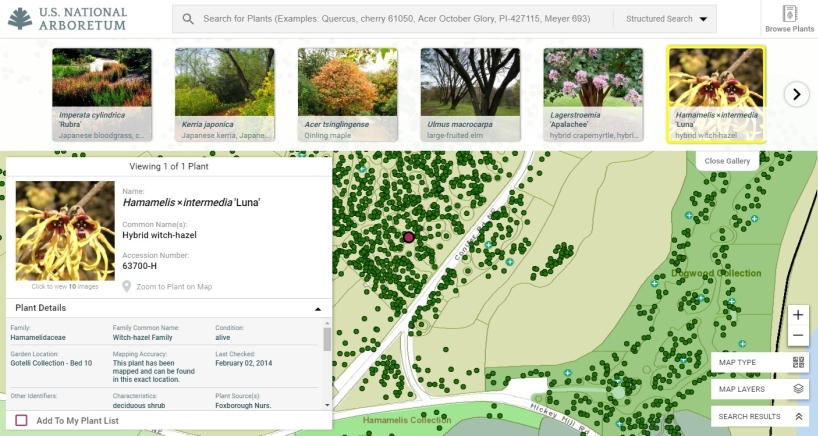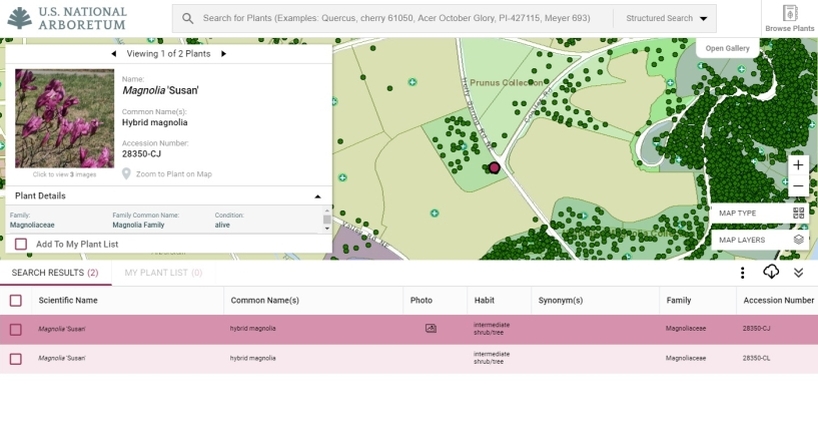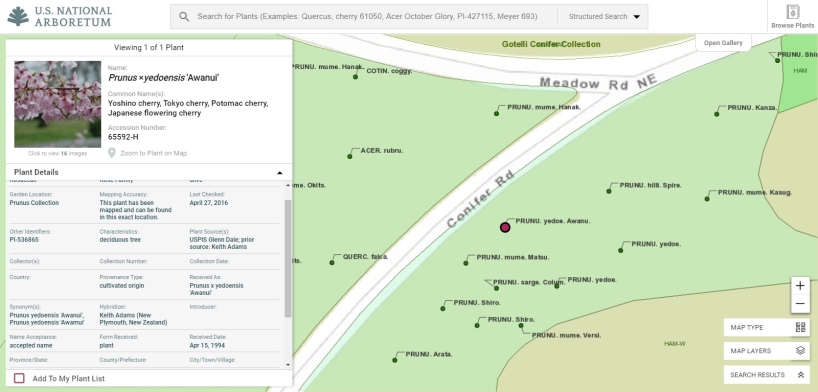Plant Finder & Interactive Map (ABE)
NOTE: Photos are currently unavailable in ABE, although the application remains fully functional otherwise. We are working to resolve the problem as quickly as possible.
Welcome to the U.S. National Arboretum’s new and improved (version 2, released 11/16/2020) Arboretum Botanical Explorer, or as we like to call it, “ABE”*. Combining our plant records, GIS maps, and images, ABE is a powerful yet fun and easy-to-use search and mapping tool for researchers, die-hard plant lovers, and novice gardeners alike. Detailed information about the Arboretum’s accessioned plants is available by clicking right on the map, using the simple search box, the responsive plant name browse, or the more complex structured search. An exciting new feature is the randomized image carousel; scroll through it to see endless images of plants, and then click any image to see the plant’s detailed information and location on the grounds. You can also use ABE to plan your visit to a particular must-see plant, download detailed accession data, or just have a look around.
ABE is optimized for viewing on a computer with a mouse, but can work with any pointing device. Zoom in and out using your mouse’s scrolling wheel or the on-screen controller, or on a keyboard using key combination ctrl+ (to zoom in) or ctrl- (to zoom out). Click, hold and drag the cursor to pan the map in any direction, and click on any circle to see detailed information about the plant or plants it represents, along with any photos. You can add any plant to My Plant List, a feature that will let you export all of the accession information for plants saved to the list into a downloadable .CSV file.
User tips: Plants are shown on the map using two different clickable icons: medium green circles () and larger, blue-green circles with white plus signs (). The medium green circles represent plants that have been mapped precisely where they are growing. The larger circles with plus signs represent all of the unmapped plants growing in each garden bed, to give you an approximate location (the circles are usually found near the center of each bed, which is outlined with a thin, green line).
Searching is easier than ever; there is a single, simple search box at the top of the screen that will let you enter names of plants or associated people, places, numbers, and codes to find exactly what you want. A selectable list of suggested matches will appear as you type, but you can hit “enter” or click the button to perform the full search. Then, use the helpful search results table at the bottom of the screen to further sort and select the plants you want to view. Clicking on any column header will sort the table accordingly. From the search results table, you can also select some or all of the plants to add them to My Plant List, and export the information about these plants to a .CSV file by clicking the download cloud icon. To add or remove columns (not all are displayed automatically and only those displayed will be exported), choose the three-dot icon to specify the categories you want included.
If you’re not sure which plants you’re looking for yet, or how their names are spelled, try the “Browse Plants” feature in the upper-right corner. You can see and select both common and scientific names of our living plants, and a live search box will narrow your results as you type. Once you select a name, a table will appear at the bottom listing the matching plants. You can then choose exactly which individuals you would like to see in closer detail.
For users with very specific needs, the more targeted Structured Search allows direct searching on Arboretum accession numbers, field collection numbers, country of origin and many other criteria in separate fields. Fill out any combination of requirements (fewer criteria will give a larger number of results) and then use the search results table to make your final selections.
We’re always hard at work mapping more plants, taking more pictures, and making improvements to ABE. We welcome your feedback! Email Stefan Lura (stefan.lura@usda.gov) with your comments and suggestions.
*The acronym also recalls the founder of the United States Department of Agriculture, President Abraham Lincoln. The Arboretum is part of the USDA’s Agricultural Research Service.

 ) and larger, blue-green circles with white plus signs (
) and larger, blue-green circles with white plus signs ( ). The medium green circles represent plants that have been mapped precisely where they are growing. The larger circles with plus signs represent all of the unmapped plants growing in each garden bed, to give you an approximate location (the circles are usually found near the center of each bed, which is outlined with a thin, green line).
). The medium green circles represent plants that have been mapped precisely where they are growing. The larger circles with plus signs represent all of the unmapped plants growing in each garden bed, to give you an approximate location (the circles are usually found near the center of each bed, which is outlined with a thin, green line).
